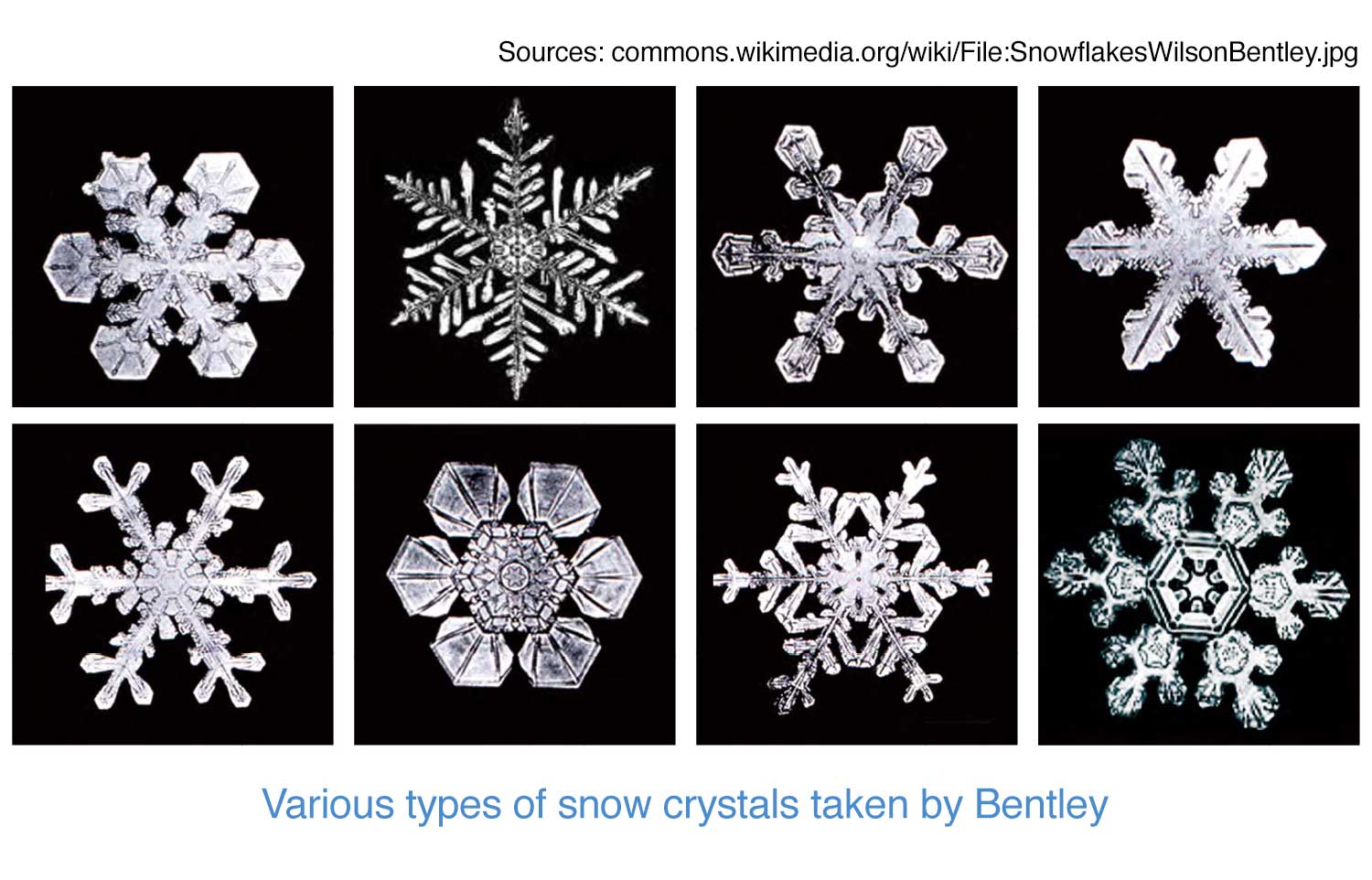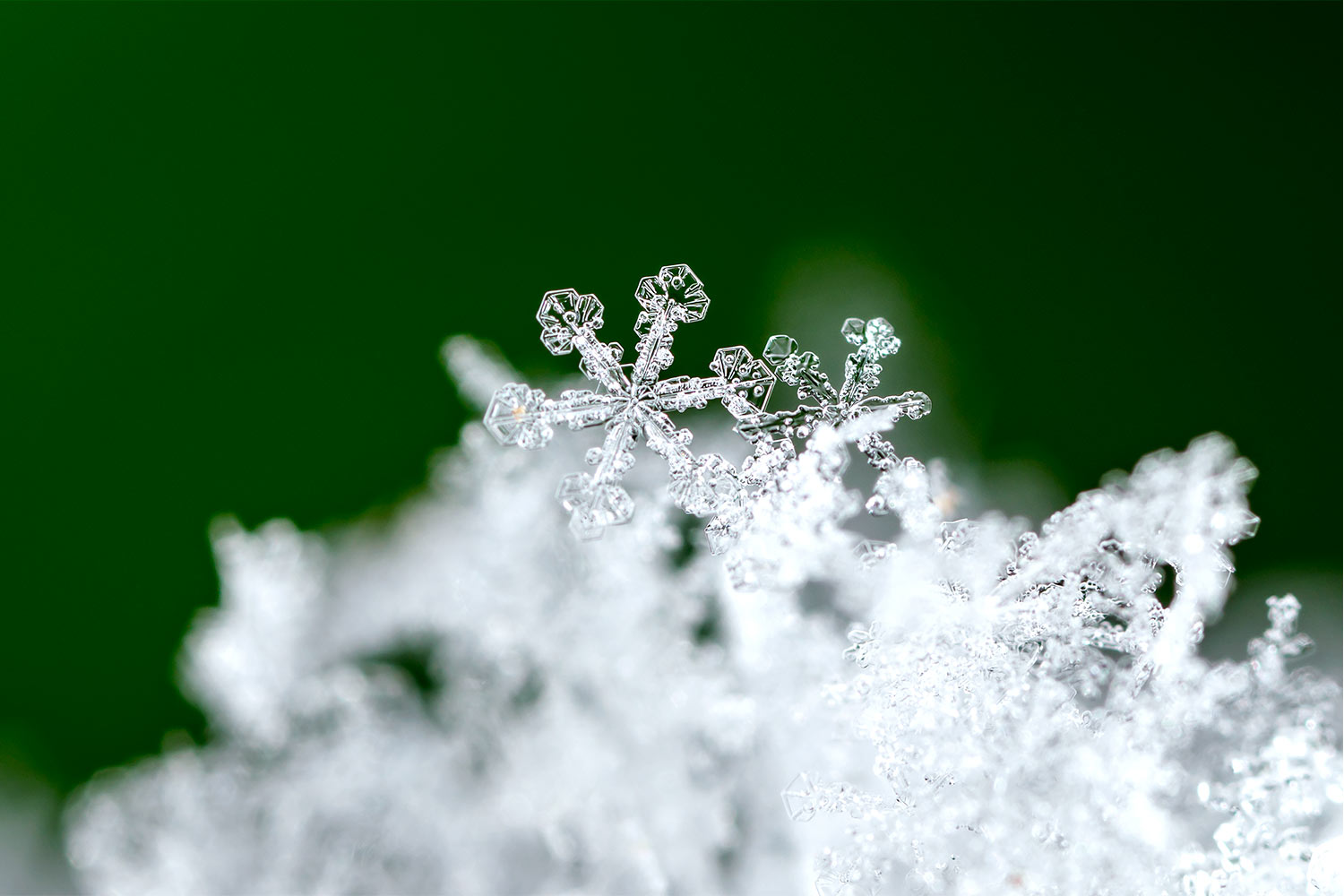
On a snowy morning, even the cold winter feels cozy and warm. Thick snow covers everything white, and snow flowers that bloomed overnight on every tree branch look like there’re going to fall off at any moment. This quiet winter scene, where time seems to have stopped, is a gift from the heavens. The scenery covered with snow, where the sun shines through the clear air, is dazzlingly beautiful.
The snow scenes are beautiful, but if you take a close look at the snowflakes, you will find they are even more splendid than what they look like on the outside. Open your eyes big and take a close look at the snowflakes, and you will find beautiful jewels, the gifts of nature, which are all different from each other.
People who found the beauty of snowflakes before anybody else were scientists. The snowflakes that landed on the shoulder of Johannes Kepler, a German astronomer during the Renaissance, fascinated him more than the stars shining in the sky. After making a careful observation of snowflakes, he was amazed by the order of nature. Snowflakes thought to be some small chunks of ice were turned out to be six-cornered. Although microscopes were rare at that time, he let the world know the order of snow crystal through a short essay, The Six-cornered Snowflake. Snowflakes’ structures that surprised Kepler were known in more detail by Descartes, an outstanding scholar in many aspects such as mathematics and physics. He described various kinds of snowflakes in his book Meteorology. He wrote, “They are perfect hexagons. The six sides are very straight, and the six angles are of the same size. It is impossible for humans to make an object this accurate.”
Then how are such beautiful and elaborate snowflakes made? Snowflakes are made in the clouds 3,000 meters [9,840 ft] above ground. In the clouds, about 1 quadrillion crystals are formed every second. When vapor freezes below 0°C [32°F] and comes down to the ground, it is called snow. However, not all vapor becomes snow. A nucleus is needed to gather the vapor and make a crystal. When the cold vapor meets a fine solid particle, it becomes a tiny six-cornered snow crystal. This tiny crystal grows to be a small ice star, moving through different temperatures and humidity zones in the clouds. According to the temperature and humidity of the clouds, the shape of snow crystal is determined; star-shaped snowflakes and tree branch-shaped snowflakes are formed between -10°C to -20°C [14°F to -4°F], and the crystals that are formed above or below that temperature have hexagonal columns. When these snow crystals are combined together while floating around in the clouds and become heavy, they fall from the sky due to gravity; these are snowflakes.

The shapes of the snowflakes are delicately different but are in the form of the regular hexagon is because of the shape of water molecules, the materials of the snow. Most molecules are in a rectilinear figure or a tetrahedral figure. However, the molecules that are combinations of two hydrogen atoms and one oxygen atom are not straight but a little bent with the degree of 104.5°. When it freezes in the cold temperature, six bent water molecules make a hexagon formation, as if playing a circle dance by holding hands.
There is a man who was fascinated by the beauty of snowflakes all his life. He is Wilson Bentley, born in a farm family in Vermont, U.S. He happened to see a snow crystal with the microscope his mother bought him when he was fifteen. This made a 180 degree change in his life. He purchased a camera at a high price and attempted to take pictures of the snow crystals. It’s hard to take pictures of snowflakes because they disappear in a few seconds or minutes after landing on the ground. After much trial and error, he succeeded in taking a picture of snow crystals in black and white, two years after he started it. His pictures let the world know the elegant structure and the perfect symmetry of snow crystals and their varieties. He took pictures of snow crystals until right before he died of pneumonia at 66. “I took a lot of pictures of snowflakes, but no two snowflakes are alike,” he said.

There are numerous snowflakes even in a handful of snow. Ever since the earth was formed, snow that is ten times the volume of the earth has covered the surface of the earth and disappeared. What is amazing is that all those snowflakes look different from each other. The basic forms of snow crystals are the plate shape, the star shape, the needle shape, and the tree branch shape, but none of them are alike.
The elaborate and diverse shapes of snow crystals are decided according to the arrangement of their molecules. A snow crystal is only 1 to 2 mm, but these snow crystals consist of more than 1 quintillion (1018) water molecules. Depending on the arrangement of those countless molecules that form snowflakes, the shape varies. For example, let us think how many ways there are to put ten different books on a bookshelf. There are 3,628,800 ways. (In mathematics, there are 10!=10×9×8×7×6×5×4×3×2×1=3,628,800 ways to arrange ten books.) This is with just ten books. Then, the number of ways to arrange countless water molecules that form snowflakes is almost infinite. Various arrangements of water molecules are the reason there are no snowflakes that look exactly the same among countless snowflakes that have come down so far.
Then does artificial snow, made with a snow gun, have beautiful and diverse forms like natural snow? People make artificial snow by freezing small water drops in the air. Strictly speaking, it is more like sleet than snow. People think that frozen rain drops are snowflakes, but they are sleet. Sleet does not have beautiful shapes or symmetry like snowflakes. The snow which is made in nature form crystals little by little while floating around in the clouds, but artificial snow or sleet are made as water drops are frozen at a high speed. That’s why they have very simple structures, unlike tree branch shapes or star shapes of snowflakes made in nature. It is amazing that all the snow crystals in nature grow to be six-cornered but no two are alike. Despite the development of science, we cannot fully explain the mystery contained in it.

The stars shining in the sky, unknown flowers in the field, and humans are in certain order but are all different from each other. How can such small pieces of ice, made in clouds and come down to the ground, be so delicate and fine? Take a good look at snowflakes that sit on your winter coat on a snowy day. You will find a piece of the Creator’s fingerprint in the snowflake.